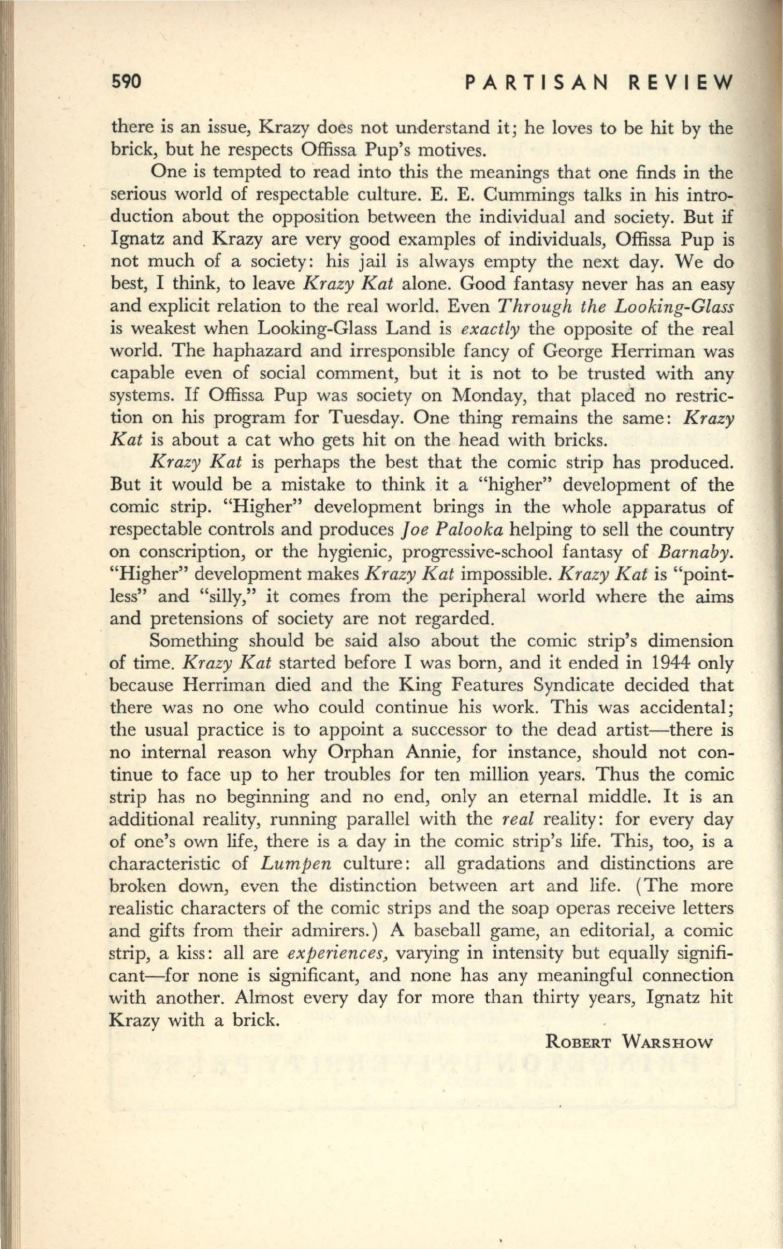
590
PARTISAN REVIEW
there is an issue, Krazy does not understand it; he loves to be hit by the
brick, but he respects Offissa Pup's motives.
One is tempted to read into this the meanings that one finds
in
the
serious world of respectable culture. E. E. Cummings talks in his intro–
duction about the opposition between the individual and society. But if
Ignatz and Krazy are very good examples of individuals, Offissa Pup is
not much of a society : his jail is always empty the next day. We do
best, I think, to leave
Krazy Kat
alone. Good fantasy never has an easy
and explicit relation to the real world. Even
Through the Looking-Glass
is weakest when Looking-Glass Land is
exactly
the opposite of the real
world. The haphazard and irresponsible fancy of George Herriman was
capable even of social comment, but it is not to be trusted with any
systems.
If
Offissa Pup was society on Monday, that placed no restric–
tion on his program for Tuesday. One thing remains the same:
Krazy
Kat
is about a cat who gets hit on the head with bricks.
Krazy Kat
is perhaps the best that the comic strip has produced.
But it would be a mistake to think it a "higher" development of the
comic strip. "Higher" development brings in the whole apparatus of
respectable controls and produces
Jo e Palooka
helping to sell the country
on conscription, or the hygienic, progressive-school fantasy of
Barnaby.
"Higher" development makes
Krazy Kat
impossible.
Krazy Kat
is "point–
less" and "silly," it comes from the peripheral world where the aims
and pretensions of society are not regarded.
Something should be said also about the comic strip's dimension
of time.
Krazy Kat
started before I was born, and it ended in 1944 only
because Herriman died and the King Features Syndicate decided that
there was no one who could continue his work. This was accidental;
the usual practice is to appoint a successor to the dead artist-there is
no internal reason why Orphan Annie, for instance, should not con–
tinue to face up to her troubles for ten million years. Thus the comic
strip has no beginning and no end, only an eternal middle. It is an
additional reality, running parallel with the
real
reality: for every day
of one's own life, there is a day in the comic strip's life. This, too, is a
characteristic of
Lumpen
culture: all gradations and distinctions are
broken down, even the distinction between art and life. (The more
realistic characters of the comic strips and the soap operas receive letters
and gifts from their admirers.) A baseball game, an editorial, a comic
strip, a kiss: all are
experiences,
varying in intensity but equally signifi–
cant-for none is significant, and none has any meaningful connection
with another. Almost every day for more than thirty years, Ignatz hit
Krazy with a brick.
RoBERT
W
ARSHOW


